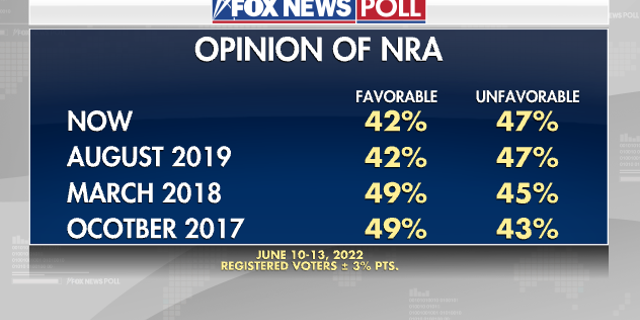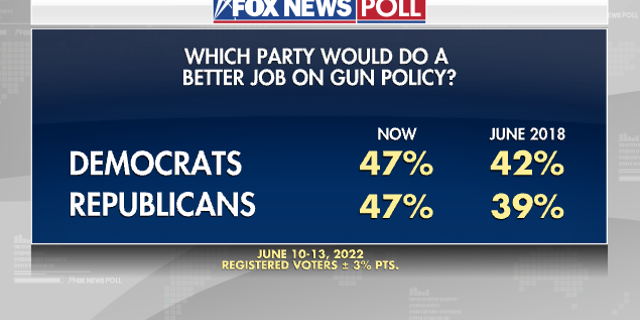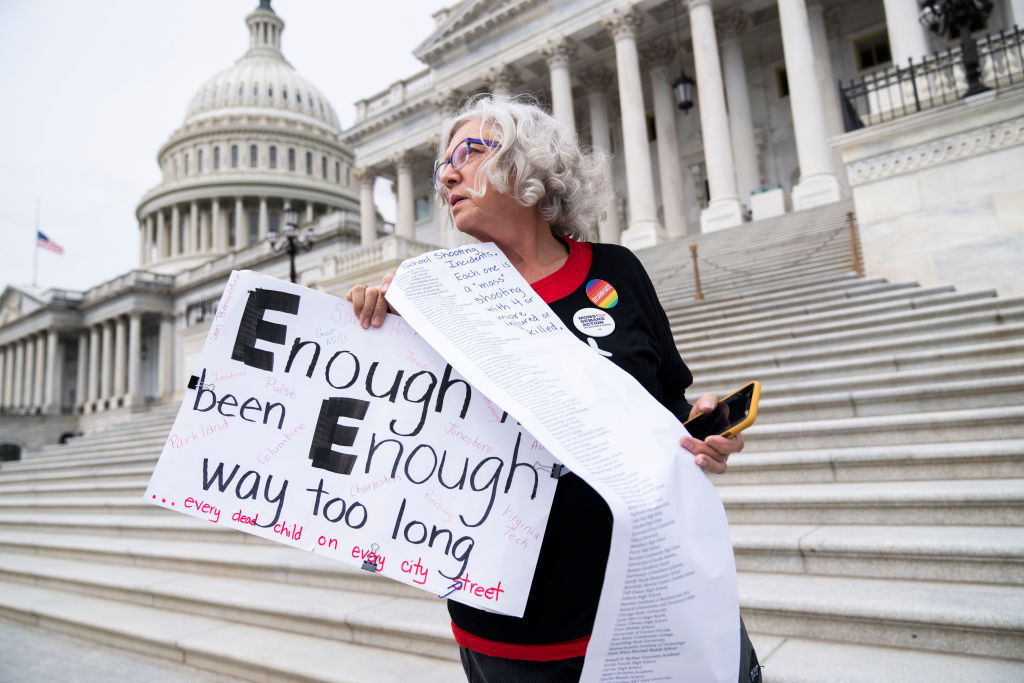NEWYou can now listen to Fox News articles!
After a series of recent mass shootings, the latest Fox News national survey shows bipartisan support for a range of gun reform laws, especially background checks on all gun buyers.
In general, a 56% majority believes that having tougher gun laws would reduce mass shootings in the United States, while 39% do not.

The Gun Laws Poll
(Fox News)
On specific gun proposals, voters are most supportive of requiring background checks on all gun buyers (88%) and improving enforcement of existing gun laws (84%).
Another 8 in 10 favor raising the legal age to buy assault weapons to 21 (82%), passing “red flag” laws that allow police to take guns from people shown to be a danger (81%), background checks on buying ammunition (80%), mental health checks (78%), and raising the legal age to buy any gun to 21 (78%).

The Reduce Gun Violence Poll
(Fox News)
Roughly, three-quarters favor requiring a 30-day wait period for all gun purchases (77%) and increasing the number of armed guards at schools/public venues (73%).
Seven in 10 favor banning high-capacity ammunition clips (70%), while slightly less (63%) support banning assault weapons.
The only proposals tested that lack majority support are allowing teachers to carry guns at schools (48%) and encouraging more citizens to carry a weapon (45%).
Majorities of Democrats and Republicans agree on each of the policies tested, with at least three-quarters in agreement on the top items like background checks, “red flag” laws, enforcing existing gun laws, mental health checks, and raising the legal age to 21. Partisans disagree on banning assault weapons (84% of Democrats favor vs. 44% of Republicans), more citizens carrying guns (30% vs. 60%), and allowing teachers to have guns (29% vs. 67%).
At least half of both parents and gun-owning households support each of the measures tested on the survey. Majorities of veterans are also likely to support them, with the exception of encouraging more citizens to carry guns (47% favor that).
Despite broad and bipartisan support for specific gun reforms, voters split on what the country should focus on first to reduce gun violence: 44% say “gun control laws,” while 46% say “other things, like how we treat mental illness and raise our children.” That is a stark shift from 7 years ago when 19% chose gun control and 67% said mental health/children (October 2015).

The Reduce Gun Violence Poll
(Fox News)
That change in priorities shows up across a wide range of demographic groups: Hispanics (+37 percentage points), Democrats (+33), women (+26), men (+25), gun households (+24), Black voters (+23), and Republicans (+20) are all more likely to want to start with gun control laws compared to 2015.
Overall, 6 in 10 think it is more important to protect citizens from guns while 4 in 10 are more concerned about gun rights. Partisan differences are alive and well here, with most Democrats (86%) prioritizing protecting citizens from gun violence and a majority of Republicans (65%) looking to protect the Second Amendment.

The Protection Importance Poll
(Fox News)
Gun households divide on the issue: 47% gun rights vs. 48% citizen protection.
The poll of registered voters was conducted June 10-13, soon after the May 24 shooting in Uvalde, Texas that resulted in the deaths of 19 elementary school students and 2 teachers, and about a month after the May 14 racially-motivated shooting in Buffalo, New York that resulted in the deaths of 10 Black shoppers and workers at a supermarket. Both shooters used legally purchased AR-15 style rifles.
When asked to say in their own words why mass shootings happen more often in the U.S. than in other countries, voters’ top responses are the lack of gun laws (36%), mental health issues (15%), the lack of proper parental guidance (5%), and the availability of assault weapons (5%).

Reason for Gun Violence Poll
(Fox News)
Democrats (48%) are almost twice as likely as Republicans (25%) to say the lack of gun laws is the main issue. Republicans are divided between the absence of mental health treatment (21%) and gun laws.
For parents, lack of gun laws and mental health remain in the top two spots, while “parenting” comes in third.
On Sunday, Senate negotiators announced the framework of a bipartisan deal on a limited amount of gun safety measures in response to recent shootings.
This prompted a response from the National Rifle Association (NRA) in a series of tweets, including:
“NRA will continue to oppose any effort to insert gun control policies, initiatives that override constitutional due process protections & efforts to deprive law-abiding citizens of their fundamental right to protect themselves/loved ones into this or any other legislation.”
By a 5-point margin, more voters view the NRA negatively (47% unfavorable) than positively (42%). That’s unchanged from three years ago in August 2019, shortly after the El Paso, Mexico and Dayton, Ohio mass shootings (47% unfavorable vs. 42% favorable).
WAPO COLUMNIST ‘EXCITED’ THAT TOP DEMS AND ‘MANY IN THE MEDIA’ WANT GUN CONTROL

Opinion of NRA Poll
(Fox News)
2022 Midterms
Voters are clear on what issue will influence their vote in the 2022 midterm elections, as 41% say inflation. While the issue of guns is a distant second (12%), it’s ahead of other priorities like abortion (10%), border security (7%), climate change and crime (5% each), election integrity and voting rights (4% each), coronavirus (3%) and foreign policy (1%).
Who do they trust on the gun issue? It’s a split verdict: 47% say the Democrats and 47% say the Republicans. Four years ago, Democrats had a slim 3-point lead on the issue (June 2018).

What party does better on gun control poll
(Fox News)
President Biden’s job rating on guns is underwater by 27 points: 33% approve vs. 60% disapprove. His numbers are somewhat better on border security (-23 points) and his response to Russia’s Ukraine invasion (-10), and worse on the economy (-38) and inflation (-48).
Biden’s overall job rating is underwater by 14 points, his worst showing to date (43% approve vs. 57% disapprove).
CLICK HERE FOR TOPLINE AND CROSSTABS.
Conducted June 10-13, 2022 under the joint direction of Beacon Research (D) and Shaw & Company Research (R), this Fox News Poll includes interviews with 1,002 registered voters nationwide who were randomly selected from a national voter file and spoke with live interviewers on both landlines and cellphones. The total sample has a margin of sampling error of plus or minus three percentage points.

